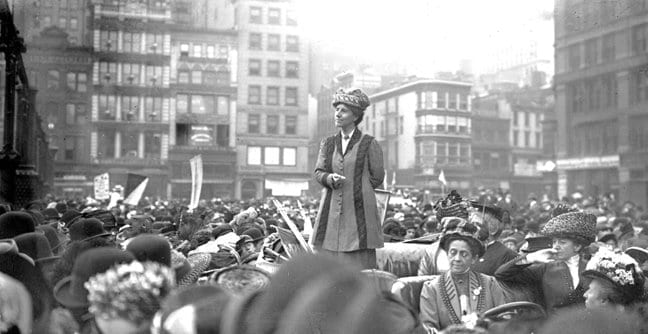By Kathleen Cui ~
Charlotte Perkins Gilman (1860-1935) was known for excellence in many domains, ranging from her work as a renowned novelist to her role as a lecturer on social reform.[1] Born just prior to the civil war in Hartford, Connecticut, Gilman’s life works reflect the social and intellectual context of the post-civil war decades. Gilman was raised by a single mother after her father abandoned the family, and consequently grew up in conditions of genteel poverty that detracted from the quality of her education.[2] Nonetheless, her impressive literary skills spanned across fiction and nonfiction, and contemporarily she is well known for “The Yellow Wallpaper,” a semi-autobiographical short story relating her experiences with postpartum depression.[3] Gilman’s work as a Progressive Era social theorist, including deliberation on the role of economics in achieving gender equality, was integral to the nationwide discussion of women’s rights. But despite her trailblazing contributions to the feminist movement, Gilman’s social theories included many proposals and tenets that would now be classified as overtly racist and discriminatory to marginalized groups she deemed defective. In this essay, I will first discuss a number of her nonfiction writings on gender and race relations, before going on to demonstrate how her feminism and racism were able to harmoniously function due to their roots in her version of nationalism. Although the staggered progressiveness across her beliefs may strike present-day readers as contradictory or confusing, Gilman drew from both her feminist and racist ideologies to form her idea of a more perfect civilization, which in retrospect reads more nativist than nationalist.
Among her non-fiction works, Gilman was best known for her book Women and Economics: A Study of the Economic Relation Between Men and Women as a Factor in Social Evolution[4], published in 1898. The book’s introduction, written by Michael Kimmel and Amy Aronson, notes that her work was groundbreaking for its extensive discussion of female oppression in relation to the economy, arguing for a shift in the cultural identity of a woman in America. Distinct from her peers in social theory, Gilman spearheaded the avant-garde concept of the liberation of women via economic independence from men. In the first section, Gilman makes the striking observation that humans are “the only animal species in which the female depends on the male for food, the only animal species in which the sex-relation is also an economic relation.”[5] This dependence, Gilman argues, originates from the role of women in society, in which “their labor in the household has a genuine economic value”[6] but is not adequately nor consistently compensated for. In fact, she later refers to women as “private servants.”[7] The American woman performs her role in the household as an expected duty to their family and society as a whole, rather than a legitimized line of work — consequently, “whatever the economic value of the domestic industry of women is, they do not get it.”[8] The economic stability of a woman is therefore privy to that of her husband, creating a power dynamic which precludes the possibility of true gender equality.
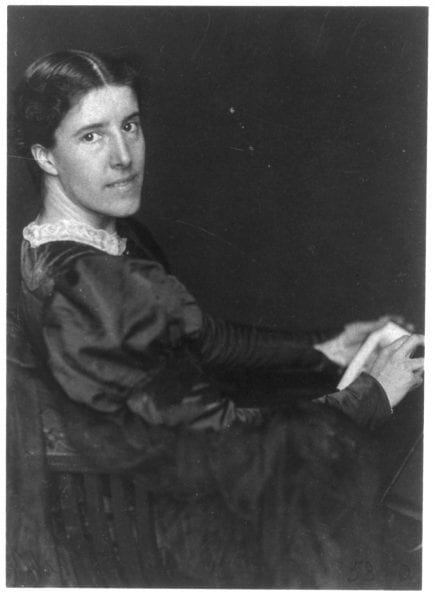
Charlotte Perkins Gilman, circa 1900. Photograph by Frances Benjamin Johnston. Source: Library of Congress Prints and Photographs division, ID cph.3a49162.
In section four, Gilman takes an anthropological approach to male-female human relations, noting that among primitive humans, “she was as nimble and ferocious as he, save for the added belligerence of the males in their sex-competition.” Over time, however, males began directly subordinating and “enslaving”[9] females, rather than competing with other males for a prospective female’s attention. When “man began to feed and defend woman, she ceased proportionately to feed and defend herself,”[10] causing her to meet “the influence of natural selection acting indirectly through the male, and developing, of course, the faculties required to secure and obtain a hold on him.”[11] By this logic, Gilman justifies that “monogamous marriage,” as a consequence, “has been growing to be the accepted form of sex-union–prostitution.”[12] The penultimate relationship between a man and woman is, functionally, an exchange of basic necessities for sexual pleasure. Gilman outlines this generic relationship and defines it as a form of prostitution, which she condemns as a social evil and therefore a hinderance to the social progress of the nation as a whole. She theorizes that a more “full, free, subtle, and easy” sexuo-economic relationship between men and women results in a “more perfect differentiation of labor and exchange of product, with their correlative institution,” and therefore a “more perfect… civilization.” The “increasing evil” of sex-union prostitution, Gilman warns, is “stronger than all the good of the civilization attained, and the nation falls.”[13]
So what is there to be done? Gilman puts it plainly: “economic independence for women necessarily involves a change in the home and family relation.”[14] Although the existence of marriage as a social construct indeed represents “an increasing development of high social life”[15] among the human species, the “economic status of marriage rudely breaks in upon love’s young dream,” because the economic dependence of women on men prevents “any higher, truer union”[16] from forming between a wed couple. Gilman argues that “marriage is not perfect unless it is between class equals,”[17] and therefore the elevation of civilization as a whole first requires improvement upon the institution of marriage.
In her discourse on the improvement of marriage, Gilman proposes thorough and detailed plans for the division of labor and economic liberation of women. For example, in noting that cooking occupies a considerable chunk of a mother’s time, Gilman suggests the “selection and preparation of food” be “in the hands of trained experts”[18] — in essence, specializing the cooking aspect of housework into “a reputable, well-paid profession, wherein those women or those men who were adapted to this form of labor could become cooks, as they would become composers or carpenters.”[19] The higher tier of skill obtained via the establishment of cooking as a profession would free up a mother’s time, allowing her to pursue other lines of work in pursuit of economic independence. Concurrently, such domestic professionalization would also serve the function of accustoming people to “scientifically and artistically prepared foods,” for the holistic effect of “better fulfilment of [women’s] duties as wives and mothers and the vast improvement in health and happiness of the human race.”[20]
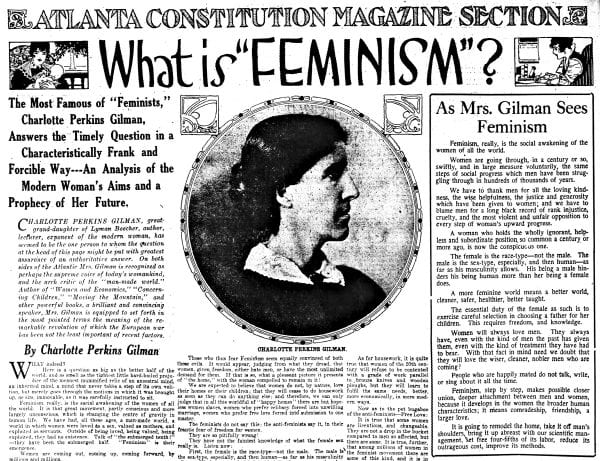
Articles about feminism by Charlotte Perkins Gilman and a photo of her as printed in the Atlanta Constitution, December 10, 1916.
Building upon her idea of professionalized housework, Gilman proposes the idea of co-op “apartment houses” designed for “professional women with families.” She outlines the structure of such a setup, delineating that “the apartment would be without kitchens; but there would be a kitchen belonging to the house from which meals could be served to the families in their rooms or in a common dining-room, as preferred. It would be a home where the cleaning was done by efficient workers, not hired separately by the families, but engaged by the manager of the establishment; and a roof-garden, day nursery, and kindergarten, under well-trained professional nurses and teachers, would insure proper care of the children.” On a granular scale, Gilman notes that even “the cleaning required in each house would be much reduced by the removal of two chief elements of household dirt, grease and ashes.” The specialization of these aspects of housekeeping, broken down into facets of cooking, cleaning, etc., would “require the service of fewer women for fewer hours a day,”[21] allowing for the same amount of work to be done more efficiently by employable individuals of any gender. With that, more women would be able to pursue professions in which they bear particular skill or interest, “thus increasing the productive power of the world.”[22] Taking into account this final consequence of professionalized housework, it becomes evident that although the mechanism of Women and Economics is female liberation via economic independence, her intended function is the bettering of civilization, inspired by her subjective viewpoint of what an ideal society looks like.
Although Gilman wrote and lectured prolifically on women’s rights issues of her time, her mediations extended beyond feminist theory into the realms of race and eugenics. In 1908, Gilman wrote an article titled “A Suggestion on the Negro Problem”[23] for The American Journal of Sociology, in it expressing consistent views involving race that are — in retrospect — far less progressive than her views on gender equality in that same time period. Gilman summarizes the “Negro Problem” referenced in the article’s title — and makes explicit the two races referenced throughout the article — in the following excerpt: “By consummate mishandling of the crucial period of change, the break in the relations between blacks and whites became a gulf, and has since widened. We now have an immense area of country in which are found two races, of different degrees of social advancement, living side by side, only partially serviceable to one another, and in many ways antagonistic.”[24] Gilman refers to African-Americans as “a race widely dissimilar and in many respects inferior [to Caucasians], whose present status is to us a social injury.” It is important to note that Gilman views this posited inferiority to be the natural condition of African-Americans compared to Caucasians, rather than a product of the experience and trauma of enslavement — she avers that “if we had left them alone in their own country this dissimilarity and inferiority would be, so to speak, none of our business,”[25] in turn assuming that this posited inferiority would exist independent of slavery. Gilman expresses her belief in social Darwinism and the “advantage of contact with our more advanced stage of evolution” by arguing that “the African race… has made more progress in a few generations than any other race has ever done in the same time, except the Japanese.”[26] Having potentialized the United States’ race relations in such terms, Gilman goes on to propose a model in which any “negroes who do not progress, who are not self-supporting, who are degenerating into an increasing percentage of social burdens or actual criminals, should be taken hold of by the state”[27] into a system of mandatory enlistment encompassing men, women, and children. Gilman continues that “applied labor is wealth,” and because “the unorganized negro does not seem capable in many instances of utilizing his own forces,”[28] such a system could be implemented at no cost to those enlisted, with an overall benefit to society. The uncanny similarity of Gilman’s proposal to slavery is further delineated by her concluding remark that “in case of unsatisfactory service they should be reinlisted and try some other form of labor.”[29] It goes without saying that those determining unsatisfactory service in her model are white, and the compulsorily reenlisted are not.
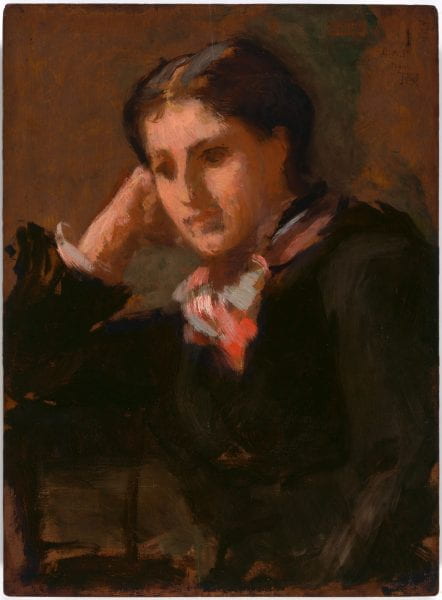
Portrait of Charlotte Perkins Gilman, 1880, by painter Ellen Day Hale. Source: National Portrait Gallery, http://npg.si.edu/object/npg_NPG.83.162
The concomitant existence of both texts and their embedded social theories requires a degree of internal negotiation for some modern-day readers: whereas Gilman’s ideas were crucial to the women’s rights movement and proved far ahead of her time, her meditations on race assumed white superiority and advocated for the refurbished subjugation of African-Americans. Contemporary scholars have made many commentaries on Gilman’s staggered progressiveness.
In her book Building domestic liberty: Charlotte Perkins Gilman’s architectural feminism,[30] Polly Wynn Allen argues that Gilman’s “stated belief in the ultimate equality of all races boiled down to an expectation that other races would become more and more like hers. She saw the United States as a molding and not a melting pot. The policies she favored featured forced assimilation into the mold of so-called civilization.” Without a “stable constituency to challenge and inform her,” Gilman waxed ignorant and arrogant, ultimately theorizing wholly inappropriate solutions on the issue of race that were both unwarranted and poorly informed. Allen notes, however, that on multiple occasions Gilman actually “expressed disgust at the behavior of dominant groups toward minorities,”[31] which seems more in line with her ideas about female liberation. Despite this purported disgust, Gilman’s own behavior reflected the typical racism observed in other white feminists of her time. For example, in her article “Charlotte Perkins Gilman and the Shadow of Racism,”[32] Denise D. Knight cites a letter written by Gilman to her daughter in 1922. In the letter, Gilman recounts how she asked to move to a different part of the train because two African-American individuals were assigned to the bed next to her, stating that “to have sat in the sun opposite those coons and their baggage? & their lunch? the boy squirming about and making all manner of noises? would have used me up pretty badly.”[33] No matter the modern affirmations or decries of Gilman’s prejudice, in action she proved to be racially discriminatory.
Gary Scharnhorst’s “Making Her Fame: Charlotte Perkins Gilman in California”[34] provides insight into Gilman’s ability to harmonize her racism with her women’s rights advocacy. In this article, Scharnhorst notes that Gilman “slipped into the orbit of nationalism almost accidentally”[35] after submitting a satirical poem to a nationalist magazine. In one of her following lectures, Gilman defined nationalism as “a system of industrial organization by which the whole nation may obtain the greatest wealth with the least exertion, and by which the whole nation may equally share in the common necessaries of life.”[36] Weinbaum goes on to note that “although by 1893-94 Stetson was filling her agenda with other reform activities, they were consistently informed by Nationalist ideas,”[37] and it was with other nationalists that Gilman “shared… a faith in the imminent realization of a utopian dream.”[38] According to Scharnhorst, Gilman “used her Nationalist lectures to champion the economic independence of women, her most characteristic and recurrent theme.”[39] Indeed, upon closer analysis it becomes clear that Gilman’s nationalist beliefs permeate and underpin her theoretical texts. The attainment of a more perfect civilization, as referenced in Women and Economics, parallels the realization of a utopian dream, for which she often found creative release via her other utopian fiction works. At the end of “A Suggestion on the Negro Problem,” Gilman asserts that her proposed mandatory emancipation is actually “a plan of education that would make the whole race rise in social evolution.”[40] Her proposals involving gender equality and racial inequality are consistently justified with the same guaranteed, overall benefit to the nation as a whole, the root of her ponderings and the darling of her efforts.
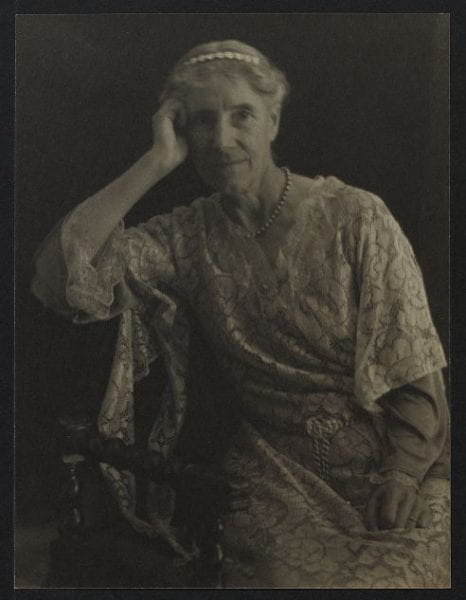
Charlotte Perkins Gilman in her later years. Source: Schlesinger Library on the History of Women in America.
Such an interpretation of Gilman’s internal rationalization of her social theories sheds some light on other issues discussed in, or conversely excluded from, her writings. For example, in her article “Eugenic Feminism: Mental Hygiene, the Women’s Movement, and the Campaign for Eugenic Legal Reform, 1900‐1935,”[41] Mary Ziegler calls attention to Gilman’s involvement in the eugenics movement. After founding the monthly magazine “The Forerunner” in 1908, Gilman developed and printed her own model of feminist eugenics over the course of the magazine’s production. Ziegler quotes one of Gilman’s submissions, in which Gilman avers “if we had proper regard for human life we should take instant measures to check supply of the feeble‐minded and defective persons.” Ziegler also notes that “by the early 1920s, Gilman was routinely advocating for eugenic causes, particularly for laws against interracial mixing, in major American magazines.” And although gender equality and racial inequality seem to reside at opposite ends of the progressive spectrum, their common roots in her nationalist beliefs actually manifested in a symbiotic relationship: Gilman advocated strongly for the “liberation of women through birth control,” which would confer women greater choice over the timing and frequency with which they bore children and were burdened by the particular responsibilities of motherhood; however, Ziegler notes that she also wrote in The Forerunner on the purpose of birth control being “to cease the producing defectives, and to begin the conscious improvement of our stock.”[42] Thus, although Gilman’s birth control advocacy proved valuable to the overall feminist movement, she in particular “saw birth control as an ideal eugenic feminist reform: one not only designed to guarantee social equality for women but also able to prevent racial decline.”[43]
In regards to contraceptives, Gilman actually weaponized her women’s rights advocacy in service of her racism. To her, contraceptives served the dual function of giving women more control over their lives while curating the future population of those she deemed worthy of reproduction. Harkening back to A Suggestion on the Negro Problem, Gilman also alluded to the hypothetical African-Americans consigned to mandatory enlistment with the language of “defectives,”[44] an ominous omen for the reproductive rights of African-Americans with aforementioned “unsatisfactory service.” Via this perusal of her various texts, it becomes clear that Gilman’s feminism had a very specific idea of whom it was meant to benefit. Even operating strictly within the realm of white women in her time, Gilman’s social theories were specifically crafted with the middle-class white woman in mind. In Women and Economics, the ideas proposed for professionalized housework, and therefore hired help, fail to consider the working-class woman who was already employed outside the home and still could not afford hired help. In her article “Feminist Criticism, ‘The Yellow Wallpaper,’ and the Politics of Color in America,”[45] Susan Lanser aptly incises that Gilman’s work is permeated by a “white, female, intellectual-class subjectivity… whose illusory unity, like the unity imposed on the [yellow wallpaper], is built on the repression of difference.”[46]
In summary, Gilman’s advocacies for gender equality and racial inequality — which may initially appear at odds to a contemporary reader — both stemmed from and sought a common landing pad in her fundamental nationalist desire for a particular and homogeneous citizenry. In reflecting on her contributions to women’s suffrage and reproductive rights, her particular idea of gender equality actually excluded nearly every variety of women except her own: the middle-class white woman. While her arguments for women’s rights served feminism as a whole, she proffered birth control as a eugenic mechanism against the reproductive rights of African-Americans, her nationalism ultimately taking the shape of nativism. Her success on paper and in lecture speak to the popularity of her stance, and informs our modern understanding of white feminists who may have shared similar — though perhaps less openly and effectively articulated — rationale for their views on intersectionality. No matter the true ubiquity of Gilman’s particular methodology, these primary and secondary texts speak to the imperativity of reflecting on our acclaimed sociological paragons, in particular those who aver through the medium of privilege, with careful and thorough scrutiny.
About the author:
Kathleen Cui is a 4th year undergraduate student from the Bay Area studying creative writing at the University of Chicago. She has completed the pre-medicine track at the college, and hopes to one day work as a physician and continue advocacy for health equity. Outside of her coursework, she is involved in mental health activism and sexual education on campus, and in her free time she enjoys reading, snowboarding, and rock climbing.
References:
Featured Image: Charlotte Perkins Gilman at a suffrage demonstration in Union Square, New York City. Source: Schlesinger Library Charlotte Perkins Gilman Digital Collection.
[1] “Charlotte Perkins Gilman.” Biography.com, A&E Networks Television, 17 June 2020, www.biography.com/writer/charlotte-perkins-gilman.
[2]Scharnhorst, Gary. “Making Her Fame: Charlotte Perkins Gilman in California.” California History, vol. 64, no. 3, 1985, pp. 192–201., doi:10.2307/25158304.
[3] Gilman, Charlotte Perkins. The Yellow Wallpaper. The New England Magazine, 1892.
[4] Gilman, Charlotte Perkins. Women and Economics: a Study of the Economic Relation between Men and Women as a Factor in Social Evolution by Charlotte Perkins Stetson. G.P. Putnam’s Sons Boston, 1899.
[5] Ibid., p. 5.
[6] Ibid., p. 13.
[7] Ibid., p. 211.
[8] Ibid., p. 14.
[9] Ibid., p. 60.
[10] Ibid., p. 61.
[11] Ibid., p. 62.
[12] Ibid., p. 28.
[13] Ibid., p. 73.
[14] Ibid., p. 210.
[15] Ibid., p. 215.
[16] Ibid., p. 219.
[17] Ibid., p. 220.
[18] Ibid., p. 237.
[19] Ibid., p. 240.
[20] Ibid., p. 251.
[21] Ibid., p. 242.
[22] Ibid., p. 245.
[23] Gilman, Charlotte Perkins. “A Suggestion on the Negro Problem.” American Journal of Sociology, vol. 14, no. 1, 1908, pp. 78–85., doi:10.1086/211645.
[24] Ibid., p. 79.
[25] Ibid., p. 78.
[26] Ibid., p. 80.
[27] Ibid., p. 81.
[28] Ibid., p. 82.
[29] Ibid., p. 85.
[30] Allen, Polly Wynn. Building Domestic Liberty: Charlotte Perkins Gilman’s Architectural Feminism. Univ. of Massachusetts Press, 1988.
[31] Ibid., p. 53.
[32] Knight, Denise D. “Charlotte Perkins Gilman and the Shadow of Racism.” American Literary Realism, vol. 32, no. 2, 2000, pp. 159–169. JSTOR, www.jstor.org/stable/27746975.
[33] Ibid., p. 167.
[34] Scharnhorst, Gary. “Making Her Fame: Charlotte Perkins Gilman in California.” California History, vol. 64, no. 3, 1985, pp. 192–201. JSTOR, www.jstor.org/stable/25158304.
[35] Ibid., p. 194.
[36] Ibid., p. 196.
[37] Ibid., p. 199.
[38] Ibid., p. 201.
[39] Ibid., p. 196.
[40] Gilman, Charlotte Perkins. “A Suggestion on the Negro Problem.” American Journal of Sociology, vol. 14, no. 1, 1908, p. 85., doi:10.1086/211645.
[41] Ziegler, Mary. “Eugenic Feminism: Mental Hygiene, the Women’s Movement, and the Campaign for Eugenic Legal Reform, 1900‐1935.” Saint Louis University School of Law, 2008.
[42] Ibid., p. 12.
[43] Ibid., p. 13.
[44] Gilman, Charlotte Perkins. “A Suggestion on the Negro Problem.” American Journal of Sociology, vol. 14, no. 1, 1908, p. 84., doi:10.1086/211645.
[45] Lanser, Susan S. “Feminist Criticism, ‘The Yellow Wallpaper,” and the Politics of Color in America.” Feminist Studies, vol. 15, no. 3, 1989, pp. 415–441. JSTOR, www.jstor.org/stable/3177938.
[46] Ibid., p. 435.

